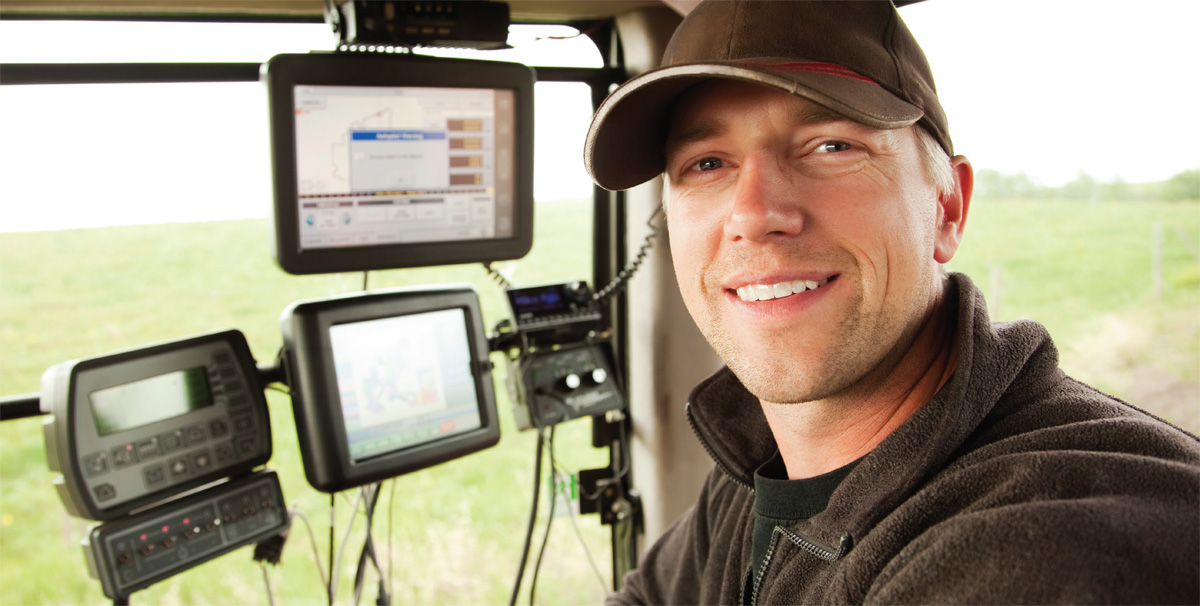FEATURED FALL 2016 ISSUE
Today's Conscientious Farmer
A good steward of the land, efficient energy consumer and high-yield producer.
For U.S. farmers, the recent four-year stretch of corn harvests has produced 57 billion bushels of corn, the highest four-year total in the nation’s history.
And, maybe not surprisingly, these past four years have also produced what is arguably the greatest stretch of agricultural advancements when it comes to ag sustainability and environmental efforts.
With per-acre corn yields at all-time highs (the forecast for 2016 is 175 bushels per acre), farmers have found themselves focusing even more on land-first practices that help offset some of the concerns that come with unprecedented production.
Here’s what they’ve discovered: New technology has made doing the right thing for the environment, often, the best thing for their bottom line.
From precision ag practices to cover crops to crop rotation to low-temp corn drying, more farmers are finding that reducing their energy and environmental footprint also reduces costs.
“In the last four or five years, the technology has exploded for agriculture,” says Darrin Ihnen, the Past President of the National Corn Growers Association and current Board Chair at POET Biorefining – Chancellor. “Farmers have always tried to figure out better ways to be environmentally friendly, to leave the land better than we inherited it. And the last few years have made it even easier to do things that are better for the bottom line and better for the environment.”
Steve Lewis, Vice President of Innovation at POET Research, agrees. “Higher yields over the last few years have highlighted the importance of maintaining the land,” says Lewis. “Farmers realize their future depends on their ability to be good stewards of the earth. They’ve always known this, and now the technology is catching up with them.”
Drones, for instance, have literally changed the way farmers look at their fields. Drone use is at an all-time high and is expected to boom in the next ten years – agricultural drones are projected to account for 80 percent of the commercial market within the next decade, according to a report by the Association for Unmanned Vehicle Systems.
Drones are just one piece in the precision agriculture package, which includes everything from optimum seed spacing during planting to GPS-guided irrigation to GPS-guided application of fertilizer and herbicide, all of which saves money while reducing environmental impact.
“We are looking at new technologies all the time, and implementing them,” says Gary Pestorious, co-owner of Frontier Family Farms, a farm partnership in Albert Lea, MN. widely recognized for its use of technology to increase production and sustainability. “We’ve found from experience that doing the right thing for the environment is often the best thing for your business as well. That’s why we’ve seen precision ag go from just a few farmers to basically everyone tapping into the technology in some way.”
Gary’s son Cole, a sixth-generation farmer, has embraced the technical advancements. “As for precision ag, there isn’t much available that we aren’t using,” says Cole, a co-owner of Frontier Family Farms. “We’re using drones, imagery from UAVs (Unmanned Aerial Vehicles), variable-rate nitrogen, nitrate testers, yield monitors, all kinds of data. These are things we want to do from the conservation side, but the return on investment has made them things we need to do on the business side.”
For Jeremy Martin, Senior Scientist for the Union of Concerned Scientists, these last few years have brought a lot of changes when it comes to ag sustainability efforts. But one thing that is not changing anytime soon, he says, is ethanol’s expanding role in our country’s fuel system.
“Something people miss about ethanol is that it’s the biggest change to come into our fuel system in 50 to 60 years,” says Martin. “It will remain an important part of our gasoline mix for decades to come. But there’s been some backlash regarding environmental concerns. So, the farmers understand what’s at stake, and they’ve taken action to reduce their greenhouse gas footprint.”
That reduction has included a new look at some old farming practices, including cover crops, crop rotation and low-temp drying of corn.
The planting of cover crops – a practice that dates back thousands of years by ancient Chinese, Indian and Northern European farmers – has seen a recent resurgence as farmers look for better ways to hold nutrients in the soil. A current study – sponsored by POET, in partnership with Monsanto, the USDA, Iowa State University, the National Soil Health Partnership, AgSolver and others – is in year two of testing crop cover, stover removal and tillage methods on 220 acres in Iowa.
New research on crop rotation – another ancient method, dating back to Middle Eastern farmers in 6,000 B.C. – has reinforced its importance for both maximizing yields as well as conserving nutrients and combatting erosion.
And more new looks at old practices are already proving profitable. The low-temperature drying of corn has started to gain ground, as some early-adopter farmers have realized the process saves energy costs and provides better quality corn for ethanol production (see sidebar).
As ethanol production has increased, so too have the public’s questions and concerns, many of which center around the misconceptions of a fuel source that took the brunt of the blame for those environmental issues, like erosion and fertilizer runoff, that were tied to increased corn production.
But the public needs to recognize that increased corn yields has also yielded better environmental efforts.
“It comes back to education,” says Ihnen. “There are so many people who aren’t familiar with agriculture any more. They are generations removed from the land, and sometimes there’s a negative undertone because they don’t see or understand everything that we do. Of course farmers care about their land. It’s their livelihood. We just need to show people how hard we’re working to do the right thing.”
Low-temp corn drying, high rewards
While many farmers recognize the environmental importance and bottom-line business benefits of things like precision ag practices, cover crops and crop rotation, one of the practices that has been overlooked is the low-temp drying of corn, a technique that is profitable for farmers, saves energy costs and can provide better quality corn for ethanol production.
Low-temp drying of corn may not work for everyone or for every operation, but we asked a few experts – researchers, farmers employing low-temp drying – to answer some of the basic questions from their first-hand, in-the-field or in-the-lab experience.
WHY EMPLOY LOW-TEMP DRYING?
“Low-temp drying and natural airflow for corn is definitely something farmers should consider. It’s going to have the lowest energy requirement of any of the options. Take last year for example, we had a lot of corn that was harvested with moisture content at 16 to 18 percent. A lot of that corn ended up being dried with natural air and low-temp drying, and that was a big saving for those farmers.” Ken Hellevang, Extension Engineer and Professor for Ag & Biosystems Engineering at North Dakota State University
“Low-temp drying is a great way for farmers to protect that integrity of the kernel of corn and to protect their investment by not leaving it in the field, by getting the crop out of the field early, to maintain the yield that is there.”
Darrin Ihnen, Board Chair at POET Biorefining – Chancellor
ISN’T IT BETTER TO LET THE CORN DRY IN THE FIELD?
“When corn dries in the field, for every percent it dries, from 25 to 18 percent, you lose 1 percent of your yield. That’s been proven in studies. If you have 25 percent moisture corn, at 200 bushels an acre, most every farmer will agree that when you come back when it’s 15 percent moisture you’ll have only 180 bushels of yield. You can let it dry in the field naturally, with a yield loss, but as a farmer you have your risk of header loss, ear loss and field loss. In the north, you run the risk of early season blizzard.”
Darrin Ihnen, Board Chair at POET Biorefining – Chancellor
IS IT A MONEY SAVER?
“Not everybody is practicing low-temp corn drying, but they should be. There are lots of advantages. Farmers can use longer maturing, higher yielding varieties and they can harvest the corn wetter in the fall and dry it with low temps. They gain by ending up with higher test weight corn and by accessing markets requiring higher quality corn because the starch and protein quality increases. They can contract corn for delivery in September. They can increase their overall yield quite substantially. The total value to the farmer can be more than 50 cents a bushel. Drying at low temps improves the quality of the corn. For the farmers invested in ethanol, particularly in POET plants, it should improve the economic returns for them and the ethanol plant.”
Steve Lewis, Vice President of Innovation at POET Research
“It’s worth the investment. History shows us that two out of every 10 years you will have to dry every kernel of corn on your farm. If you’re using propane, that’s four times the cost of using electricity.”
Darrin Ihnen, Board Chair at POET Biorefining – Chancellor
“There are computer systems that make the process almost flawless. You set it, tell it what you want it to do, and 99 percent of the time it comes out exactly right. With this system we’re using 66 percent less electricity because we have a computer telling the fan when to turn on and turn off. ”
Cole Pestorious, co-owner of Frontier Family Farms in Albert Lea, Minn
HOW DO I START?
“You have to have the right technology in the bin. There is technology in grain bins that can monitor what’s going on so you don’t have to worry about hot spots. You can use variable fans and add equipment that can measure moisture and temperature. You can even monitor it offsite from your phone.”
Darrin Ihnen, Chairman of the Board at POET Biorefining – Chancellor
“You need enough storage to hold your grain and make sure it stays in good condition all year. You need to have the dryer capacity to dry your crop. When I was young we ran the corn dryer at the maximum. People always used to run their dryer at 230 degrees. Now we don’t go over 200. If we’re only removing 3 to 5 percentage points of moisture we’ll go down to 160 degrees. We also have a system in our bin in which a computer controls the fan. We have enough air capacity to ensure that our grain moisture stays the same. If we start hauling out in January and are still hauling out in August, it’s always 15 percent moisture.”
Gary Pestorious, co-owner of Frontier Family Farms in Albert Lea, MN









